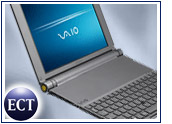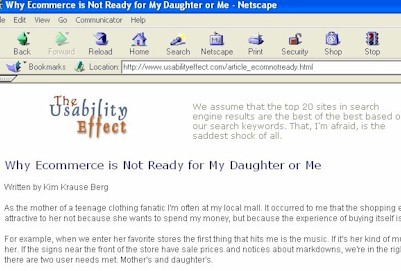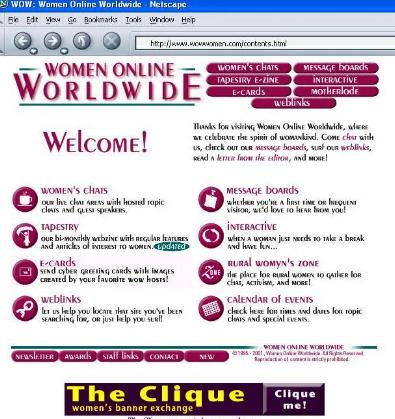Past, Present and Future

| Women
Online
Past, Present and Future |
 |
last
updated 2009 Nov 18
(the
old page http://www.witiger.com/ecommerce/womenonline2002.htm
)
 |
This web page has audio clips - just click on the icon (like the one to the left) and you can hear Prof. Richardson's voice adding additional information to topics on the page. |  |
turn on your speakers to hear audio clips |
| . | This page
used in the following courses taught by Prof. Richardson
.
This page deals with
|
 |
 |
| Sabrina Naqvi
- update 2009 Nov - rcvd an email from Sabrina that she had been accepted into the MBA program at Schulich at York University |
Reetu Gupta |
| How this unit came about | From 2001 -
mid-2004 Prof. Richardson had a brief page about "Women Online" in respect
of the growing web presence of women as students, women online customers
and women running e-businesses. As it became apparent that there was more
and more interest in some of the unique aspects of women's use of online
services, there was seen to be a need to have the content in "Women Online"
updated, and , more interestingly, written from the perspective of women.
Sabrina Naqvi and Reetu Gupta where two students in Prof. Richardson's internet marketing class at the University of Toronto in the Sept-Dec 2004 semester. Sabrina and Reetu formed a team they called SNRG and they worked together in October and November 2004 to update this page, add some fresh content, and oriented the content to represent their "demographic" - that is to say, they put in the "pink" colours and other imagery, not me ;-) anyhoo it was a good job and I appreciate their research, compilation and design. Since November 2004 there have been a few additions, from female, and male students, but the majority of the content was, and still is, the work of Sabrina Naqvi and Reetu Gupta. Witiger 2006 Oct 20 |
|
Over the past few years women have created a niche for themselves in the internet world. The start of the new meillennium changed the demographics of the internet users. Women started catching up to men in the number of average internet use, as well as the amount of other online activity including online shopping, online banking, the use of e-mail as well as portals. Presently the gender split for the number of internet users in the USA as well as Canada, is tied among men and women. Women have proven to be savy internet users making well informed decisions. The increasing percentage of women online has created communities dedicated to female issues ranging from small business support to learning online support, all over the World Wide Web. Sites such as www.studioxx.org and The Canadian Women's Internet Directory link users with Canadian women's equality resources online. The directory connects organizational and individual sites promoting awareness of women’s equality issues, debates, campaigns, activism, creativity, services, research and policy issues. A resource created by Womenspace Association, with support from Status of Women Canada. These resources are made available to women by women online. Not only is the average female internet user capable of using online services to their advantage, but they are further able to manipulate the web and create valuable information depots and use the web as an advertising tool for themselves and their businesses. The focus of this page, womenonline.htm, has evolved in the past few years. In the late 1990's and early 2000's there was a great deal of coveragae on the rise of the women online. On of the things that SNRG noted is that In the year 2004 the focus is not so much on the rise of women online, but how this rise is affecting e-ecommerce and technological advances. -WTGR and SNRG |
|
"WHO"
"Women"
|
|
| Women
Online 2001 a great
|
If you go to the J.C. Williams
site in September 2000, they don't mention the Sept 1999 report but you
can find noted that "June 14, 2000 - DoubleClick Inc. the leading
global Internet advertising solutions company today announced the release
of the first wave of findings from the Canadian Women Online Study."
formerly at http://www.jcwg.com/doubleclick-press.htm Key findings from the first wave of the Canadian Women Online Study:
"The percentage of female Canadian Internet users who have made an online purchase has grown by 21% since October 1999" |
| YanYan Y., a
University of Toronto student (UTM) in March 2008 sent an email to update
some of the information within this page
YanYan explains
|
YanYan
adds
"Here
are some numbers and projections of the online population into the
year 2012
http://techcrunchies.com/gender-distribution-of-american-internet-population/
2007:
90.8 million males and 97.3 million females
2008:
93.5 million males and 100.4 million females
2009:
96.4 million males and 103.7 million females
2010:
99.3 million males and 106.9 million females
2011:
101.9 million males and 110 million females
2012:
104.1 million males and 112.8 million females"
YanYan
concludes by saying
"From
what I experience now in 2008, I can see how much women online have
grown to use the Internet for a vast array of things. I think women
just had a slower online experience than men did when Internet was
first introduced but I think the projected numbers above are quite
accurate!
This
is why e-commerce should heavily target women, in terms of products
and services, aesthetics of their websites. Especially since there
are more women shoppers online. "
| Women
Online 2004 Women
Women
|
The following graph depicts
internet usage from the year 2000 to 2004. It shows a comparison of internet
usage between men and women. A steady increase is seen in the percentage
of women using the internet since 2000.
-In 2000 the amount of women that used the Internet was lower then the amount of men that used the Internet. In only 4 years, women have reached almost the same level of internet usage as men.
|
| Women
in past and present
|
ONLINE SHOPPING AMONG
CANADIAN WOMEN IN 2003
Further results from the Canadian Women Online Study show that online shopping has grown by 7% since July 2003 among Canadian women from 46% of female Internet users in July 2002 to 49% of female Internet users having made a purchase on the Internet . Certain categories experienced
the most dramatic increases including books (up 6% to
ONLINE BANKING
- Canadian women indicate
a preference for Internet banking for
|
| Women in past and present | ONLINE RESEARCH
DoubleClick Inc. (NASDAQ:DCLK), the leading global Internet advertising solutions company today announced the release of the third wave of findings from the Canadian Women Online Study. The Women and Automotive report is the third wave of the Canadian Women Online Study, the first nationally representative study that examines the effect of the Internet on the browsing and buying habits of Canadian women. This study revealed that more Women today will research their next vehicle purchase online before making the actual decision and before making the purchase. Moreover, the results also demonstrate that 75% of women Internet users research their Travel related purchases online before making a purchase, and between 50% and 60% of them research items such as Electronics, Computer Hardware and Software over the Internet before making a purchase decision. The majority of women today use the Internet as their prime research tool. -SNRG and Radha Calu |
| Gender
issues in health care
Online |
|
| Women driving developments of products specifically to women |
"Samsung unveiled its latest ladies phone, the SGH-T700 (SGH-T708 for chinese markets). Known as the Samsung "Drama" T700, this handset carries a unique design that is very much suited for the female user, resembling that of a cosmetic case ... also includes a calorie meter .....comes with a UFB LCD screen with over 65000 colors and 40-chord polyphonic ringtones." |
| Women driving developments of products specifically to women |
|
| Women driving developments of products specifically to women |
|
| . |
Riding into the Upscale Baby Market -SNRG |
| "WHO"
Is using the Internet women differ greatly in their online finance and payments behavior |
The significance of this article is clearly proven through the many statistics about the increase in women online. Online banking is on the rise, however the issues surrounding online security and the impact it has on potential consumers is also is a great concern to the newer users. So in order to keep both the newer and older consumers satisfied, different types of services such as viewing past bills and cheques should be offered to calm nerves. With these services, efforts must be made to ensure privacy and security to users. |
| "WHO"
Is Buying this stuff? |
Most men are known to be last minute shoppers. Women on the other hand take the time and research about the product they are about to purchase. Especially if it a more expensive product. So it only makes sense that the new independent women who has the money to buy a diamond necklace for herself rather than wait to a man to buy it for her, would do it in a modern fashion. Especially when sites aware of this new demographic offer a money back guarantee. |
| "WHO"
Is Buying this stuff? |
www.braydenking.com/weblog/archives/000088.html
a blog of a graduate student in the department of sociology at the University of Arizona Brayden discusses the latest Pew Internet & American Life report on internet use. "...women and men are just now beginning to do about the same amount of online shopping. Before 2002, more men bought things online than women. Well, sociological studies usually find that women do more shopping (and more housework overall) than do men. By this I mean that women tend to do more shopping for things like clothes, food, and other household necessities. The study also found that men tend to spend more time obtaining information about products online. This is another pattern that is different from shopping in the real world. Marketing experts claim that men spend less time sorting through products in stores and are more likely to buy the first thing they “try on” than women. In other words, women tend to spend more time gathering information about products when shopping offline." "...men and women tend to do different kinds of shopping and that the kind of shopping men do is more accessible on the internet. For example, if women are more likely to do the “household” related shopping (buying food and household necessities) they might be forced to do this offline given the few options online. Men, on the other hand, may be more likely to leisure shop (buy golf clubs, computer games, books, etc.). These kinds of products are readily available online." from a posting by Brayden January 6, 2004 |
| WHO is using this stuff? |  Making
Tech for Women: Sony's Latest Laptop Making
Tech for Women: Sony's Latest Laptop
By Mary Enderle, 08/17/04 E-Commerce Times "Women are looking for aesthetics as well as function when they buy technology, and the x505 is a notebook computer that you might want to share with everyone because it is the ultimate in exquisite design....Companies have started to focus on women as key influencers in the consumer technology purchase cycle." Despite the higher costs, this sounds like a great product! A lot more women are purchasing laptops these days. A few years ago mostly business men carried a lap top, now the functionality of a lap top has increased significantly. Students use them as their PCs, as well as professionals who travel a lot. So if Sony has a lap top that is light weight and can even fit in a larger purse, it can be said women are not going to be the only ones interested in this product. |
What Women Want?
How to target
your business towards women
| "Just
Ask A Woman" written by Mary Lou Quinlan, April 2004, ISBN: 0471369209
This book gives an insight as to what exactly women want from businesses, and how a business can succumb to a woman's needs. Fact: Today more and more women are using technology to enhance their lives. But women use technology in ways that are purposeful to them. They do not like to use complicated items that has no purpose. They like to use technology in ways to make their hectic lives easier. Lesson #1: When using technology to create inventions, make the invention in a way that will ease her life.
|
| good example: Online
Banking
The number of women today that use online banking has increased ten-fold. Women find that online banking is very purposeful and convenient to use. bad example: computerized
dishwasher
Fact: When women do online shopping, or research, they will use more than one channel to find out about a brand. They will not just perform online research of shopping in malls, they will rate your brand based on their online experience as well. Women are very purposeful in their online activity. Lesson #2: Online stores should be built like a virtual store. Easy to use, easy to navigate with no hassles. An important aspect of all online sites is customer support; support should be made readily available to users. Example: ivillage.com has recently ridden its site of all pop-up ads in order to make women's experience more relaxing and hassle free. Fact: Majority of women use the internet for research purposes. Women like to use online communities in order to do research. Websites that offers bulletin boards where women can chat and talk to others about a variety of different topics are very useful to women. example: theknot.com A wedding website which has a huge online community where brides-to-be can get advice, mother-in-laws can get advice etc. -SNRG |
|
|
Chapter 9- The
Internet Savvy Woman
Facts: 65% of women will
not shop on a poorly designed site, even if it is their favorite brand.
One bad online experience can ruin a customer's loyalty to that brand of not only their online channel, but their offline channels as well. The top 5 complaints of Online
Shopping-Study from Brigham Univeristy
|
| . | student Shamaila
S. in MGD 415 at UTM in March 2008 emailed to say "I came across another
article
http://www.rtoonline.com/Content/Article/Feb08/TipsSellingToWomen022208.asp that could adhere to the "Women's Online" category. It discusses the marketing strategy companies should consider when marketing to women. It is not specifically geared to online shopping but it can apply to Websites and shopping online." |
| 80 % | from the article
www.rtoonline.com/Content/Article/Feb08/TipsSellingToWomen022208.asp Shamaila gleaned that If businesses are losing their market it is because they failed to gear their marketing campaigns to women. Companies failed to realize that women constitute about 80% of all consumer purchases. |
| complaints | Shamaila noted
Women customers are the first to complain, more than 80% of written complaints are made by women. Women started viral marketing; not only do they complain a lot but they discuss their experiences with others. |
| more
communication |
Shamaila noted
Faith Popcorn, author of EVEolution Understanding Women,stated that women will recommend a service, store or clients to 21 other people. Women speak about 20,000 words a day compared to men who speak about 6,000 words a day. Women are the viral marketing people. |
| emotional
bonding |
Shamaila noted
If your company takes the time to understand the emotional well being of a woman's purchase then she will formulate a bond with you. This is highly important because that emotional bond she makes with you is the only way to create loyalty. This is more important than just creating a rewards points, discounts or favored customer cards? program. Women want empathy not "service" from you, they need to be understood and appreciated. By forming relationships with your women customers also creates a "referral engine" as well. |
 |
|
| Tardip says "She basically describes her experience going shopping with her daughter. She feels that no matter how advanced E-commerce gets, that it will never be able to replace the experience of shopping in person compared to online. I agree with some of her opinion, however in my opinion online shopping is not about the shopping "rush", its also about time efficiency. Why would someone want to spend hours in a crowded mall looking for deals to buy like 4 items. The internet provides you access to over a million merchants who are more than happy to accept your business. The key point that I feel her article is trying to express is that women are more sensational in the sense of touch, seeing, and smelling, and that the Internet will not be able to replace that. It's a interesting article, and there are some funny remarks as well. Enjoy!" |
Kim Krause Berg has a number
of web pages that contain useful marketing information. See www.usabilityeffect.com
Contact w Berg was made
by email 2005 Nov 29 for permission to quote and link, Copies of emails
are kept in the permissions binder.
| Ways to Keep Women Online
Improve functionality- Make the website functional and easy to use. Women like to be in control in their interactions. Organization- Make your site is organized and user friendly. When women shop, they shop with a specific purpose in mind. An organized site that helps them through this experience is a plus. example: REI.com is an online shopping site for hiking and camping gear. The site has checklists for any kind of trip and the gear you will need. Testimonials- offer testimonials from other women who have used their site, and write about their experiences. The Human Touch- Allow human connection online. Offer toll free numbers for customer service. With many users, just knowing that the option is there for human help when needed is a plus. List email addresses of experts for users to contact. Privacy- Make
sure that your standards and policies to ensurre privacy are made known
to your users.
|
 |
"Women Make The Best
Salesmen" written by Marion Luna Brem, April 2004, ISBN: 0385511620
Quote from pg 214 "Men may have written the first rules of business. That is understandable. They were the only ones allowed to do it at the time. But rules are being rewritten even as you read this. Now that women make up the majority of the buying public, it is only natural that what once worked in sales, doesn't necessarily work anymore." When marketing towards women,
you need to target their needs. Just like a marketing plan towards young
teens will differ that of a plan towards the young working adult, a plan
for men and women must be different and catered to.
|
. |
http://www.bizjournals.com/bizwomen/ - This website has journals and book listings about Women and e-commerce. Bizwomen also has events running throughout the year, and allows users to join and attend these events. www.ivillage.com- This website contains information for women from Health to Entertainment and shopping. There are various online communities and discussion boards where women can go to discuss a variety of different topics. One of the most popular websites for women. www.digital-women.com -provides an International online community for women in business, business women, and all women around the world. Inside you will find free business resources and tools including information about grants for women, free business tips, home business ideas, free marketing and sales tips, how to write a mission statement, free daily planner, how to business articles for women and an opportunity to join and promote your business right here! www.MsMoney.com - Provides women business owners with resources, a community of peers, and a central foundation to help take their business to the next level.The mission of MsMoney Inc. is to educate and empower people to take control of their financial health. We have created a variety of innovative online tools and content that help achieve this goal. MsMoney's products include: interactive seminars, CRM tools, calculators and content. MsMoney also provides specialized consulting services to help organizations with their marketing plans, design needs and women's initiatives. |
 |
Websites and Portals Strictly For Women |
| / | Gender Differences in
Communication
www.geocities.com/Wellesley/2052/genddiff.html A thought provoking page by academics about the ways men and women think differently, and subsequently interact differently online - which can allow for inferences in consumer patterns |
| / | Gender Differences in
Communication
"The Biological Basis for
Gender Based Differences in Web-Based "Discussions" and Assessment"
originaly at www.rburkett.org/AETS2.html
Dr. Burkett discusses
"With the burgeoning use of the World Wide Web as a vehicle for course delivery, equity issues in communication become extremely relevant for instructional design and evaluation of student performance. To equitably assess student contributions, it is imperative that instructors requiring some aspect of Computer Mediated Communication understand that these gender-based differences are not merely a question of style or preference. Assessment of online communication can not be a one-size-fits-all arena. Efforts must be made to celebrate these differences in communication styles while evaluating students' work in light of these differences." |
 |
These are some statistics
that predict future use of the internet by women based on the growth of
women online in the past 3 years
· Women will make up 60% of the online population by 2005 (NetSmart Research) · Women consumers online have passed the 10 million mark (CommerceNet) and women make 75% of their families’ financial decisions (Women’s Consumer Network) · *this means that online banking services are predominantly used by women! · 46% of women are decision-makers for technology purposes (Forrester Research) · 41% of women go online daily (Pew Research Center) |
|
|
CONTACT I MAIN PAGE I NEWS GALLERY I E-BIZ SHORTCUTS I INT'L BIZ SHORTCUTS I MKTG&BUSINESS SHORTCUTS I TEACHING SCHEDULE |
| . | |
| MISTAKES ITEXTS USED I IMAGES I RANK IDISCLAIMER I STUDENT CONTRIBUTORS I FORMER STUDENTS I | |
| . |